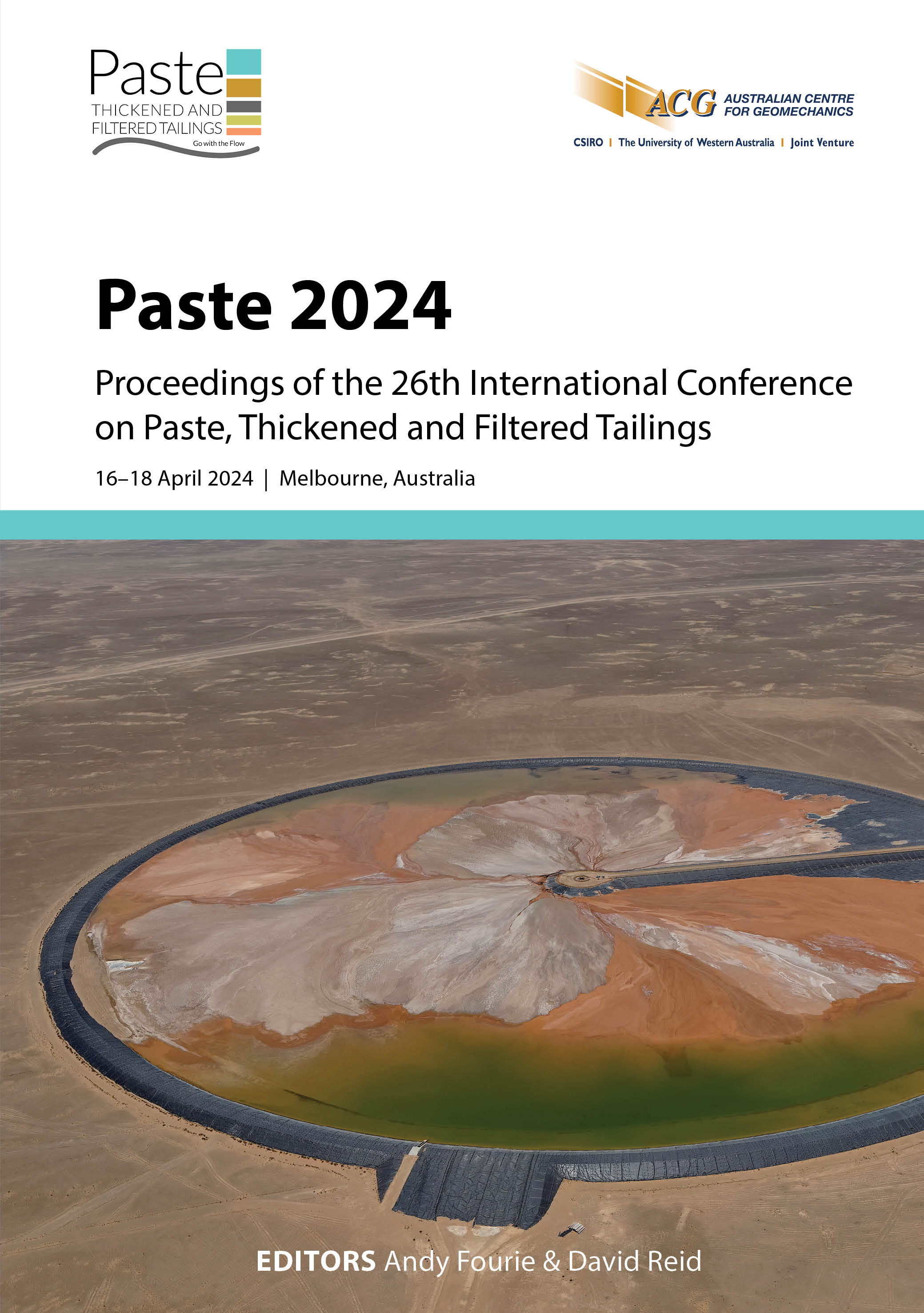A holistic approach to large-scale alternative dewatered tailings management: lessons from case studies

|
Authors: Crystal, C; Jansen, R |
DOI https://doi.org/10.36487/ACG_repo/2455_25
Cite As:
Crystal, C & Jansen, R 2024, 'A holistic approach to large-scale alternative dewatered tailings management: lessons from case studies', in AB Fourie & D Reid (eds), Paste 2024: Proceedings of the 26th International Conference on Paste, Thickened and Filtered Tailings, Australian Centre for Geomechanics, Perth, pp. 305-320, https://doi.org/10.36487/ACG_repo/2455_25
Abstract:
Large-scale alternative dewatered tailings applications are increasingly being considered in the mining industry in an era of water scarcity and focus on dam structural integrity. However, evaluating business cases for these applications is often ineffective when based on costs alone. Leveraging lessons from the authors’ multi-disciplinary team approach over several years, this paper makes the case for a new, more holistic approach to create effective business cases for evaluating large-scale alternative dewatered tailings applications. Effective business cases not only consider costs but also key drivers including physical and chemical stability, land and water usage, potential environmental impacts, and other sustainability drivers considered over the life of mine, while meeting regulatory requirements. This approach expands the battery limits traditionally used by siloed discipline engineers to examine a wider range of pathways through the tailings management system from dewatering plant to ultimate facility design. The key drivers and trade-offs that have the potential to significantly impact project economics are the focus. To optimise a case and potentially be more cost competitive, the authors propose that the tailings dewatering technology selection follows the filtered tailings storage facility (TSF) design, rather than lead the design. Rather than starting upstream at the dewatering plant and targeting a tailings solids mass concentration, it is more productive to consider the final TSF landform (and geotechnical and chemical stability requirements) and work back upstream to optimise material handling to achieve this constraint. The achievable filtered tailings moisture content or thickened tailings rheology are then determined to meet these downstream requirements. Often a hybrid system of filtered tailings with conventional wet slurry tailings provided the best technical and economic business case when considering proof of concept at scale of current filtration technologies. Benchmarking against large pilot-scale filtration studies and full-scale thin lift deposition operations was useful in identifying potential project risks and opportunities. One of the key drivers used in the proposed holistic approach is the potential water savings. Water recovery from tailings can occur at the tailings dewatering plant and/or at the TSF itself. In all cases, the balance between water recovered from one area versus another must be optimised to minimise capex, opex and operational risks. It is recommended that stakeholders collaborate to evaluate the risks and opportunities in the project planning and design stages using a systems risk-based and multi-criteria decision analysis (MCDA) approach. Using this method, considering identified key drivers, enables the making and documentation of design decisions and the identification of potential opportunities.
Keywords: large scale, filtered, stacked
References:
Aghazamani, N 2022, Unsaturated Fluid Flow and Volume Change Behaviour of Filtered Tailings, PhD thesis, Colorado State University, Fort Collins.
Brychcy, M, Dec, M & Thys, T 2020, Desalination is Not the Only Answer to Chile’s Water Problems, McKinsey & Company, Perth,
Comisión Chilena del Cobre 2022, Proyección de Demanda de Agua en la Minería del Cobre – Periodo 2022-2033, RPI 2022-A-10682, pp. 13.
Engels, J, Gonzalez, H, Aedo, G & McPhail, GI 2018, ‘Implementation of spigot discharge systems for high-density tailings at Sierra Gorda Sociedad Contractual Minera, Chile’, in RJ Jewell & AB Fourie (eds), Paste 2018: Proceedings of the 21st International Seminar on Paste and Thickened Tailings, Australian Centre for Geomechanics, Perth, pp. 389–340
Johnson, J & Vizcarra, J 2020, ‘Modernization of Chinalco Toromocho copper tailings thickeners’, in H Quelopana (ed.), Paste 2020: 23rd International Conference on Paste, Thickened and Filtered Tailings, Gecamin Publications, Santiago.
McPhail, GI 2008, ‘Prediction of the beach profile of high-density thickened tailings from rheological and small-scale trial deposition data’, in R Jewell, AB Fourie, P Slatter & A Paterson (eds), Paste 2008: Proceedings of the Eleventh International Seminar on Paste and Thickened Tailings, Australian Centre for Geomechanics, Perth, pp. 179–188,
10.36487/ACG_repo/863_17
Norambuena Mardones, RE, Caldwell-Crystal, C & Cobos, D 2023, ‘How high is too high? Challenges on the next generation of dewatered tailings stacks’, in GW Wilson, NA Beier, DC Sego, AB Fourie & D Reid (eds), Paste 2023: Proceedings of the 25th International Conference on Paste, Thickened and Filtered Tailings, University of Alberta, Edmonton, and Australian Centre for Geomechanics, Perth, pp. 465-479,
Reid, D & Fourie, A 2023, ‘Development and outcomes of a comparative slope stability design exercise’, Canadian Geotechnical Journal,
Simms, P, Grabinsky, MW & Zhan, G 2007, ‘Modelling evaporation of paste tailings from the Bulyanhulu Mine’, Canadian Geotechnical Journal, vol. 44, pp. 1417–1432.
Simms, P 2021, ‘The role of unsaturated soil mechanics in unconventional tailings deposition’, Soils and Rocks, An International Journal of Geotechnical and Geoenvironmental Engineering, vol. 44, no. 3.
Vargas, CC & Pulido, AM 2022, ‘Sustainable management of thickened tailings in Chile and Peru: a review of practical experience and socio-environmental acceptance’, Sustainability, vol. 14, no. 17.
© Copyright 2025, Australian Centre for Geomechanics (ACG), The University of Western Australia. All rights reserved.
View copyright/legal information
Please direct any queries or error reports to repository-acg@uwa.edu.au
View copyright/legal information
Please direct any queries or error reports to repository-acg@uwa.edu.au
